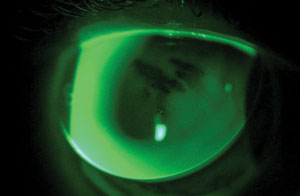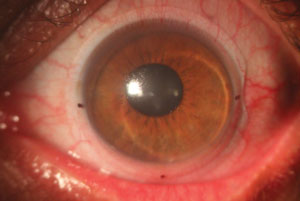 |
Custom contact lens design is a constantly evolving field, from the advent of GP lenses in 1978 to more recent developments in orthokeratology. Soft lenses in particular now feature expanded diameters, curvatures, thicknesses and sphere and cylinder powers, giving practitioners more options than ever to manage complicated prescriptions in a highly precise way. Expanded diameters enable practitioners to fit both small and large corneas of patients who would otherwise drop out of contact lens wear due to comfort or fit issues; base curve customization can also help with achieving great fit. Powers for these lenses range from +/-50D, giving even the most nearsighted patients the ability to see. With contact lenses this versatile, we can expand the amount of patients that we can help to wear contacts.
Loyalty Program
With any contact lenses—standard, toric or even multifocal—the key to a successful fit is achieving the best vision, comfort and ocular health response possible for the patient. Doing so effectively builds patient loyalty, especially when developing a contact lens specialty practice. Candidates for custom soft lenses include those who are experiencing refraction, rotation or fit issues in their current lenses due to corneal irregularity, particularly high astigmatism, and GP lens candidates who are concerned about experiencing discomfort in hard lenses. Astigmatic presbyopes are also well suited to wear custom soft lenses.
If the patient expresses dissatisfaction with the vision or comfort provided by their current lenses, try explaining that a customized lens may be more comfortable and provide better vision. When a patient sees you for their comprehensive eye exam, and you have performed a careful refraction along with keratometry readings, this could lead you to recommending custom lenses.
 | |
| Fig. 1. TruForm’s QuadraCone. Photo: Matt Kauffman, OD. |
Take this scenario, for example: “Jane, I see why your vision is not as sharp with your current contacts. The lenses you are wearing now are a ‘one-size-fits all,’ meaning that the shape of the lens only comes in one curve. Thus, you may need another shape to fit your eye properly. Also, your current lenses only correct most of your prescription, not all of it. A more custom lens may fit your eye better and give you better vision.” Adjusting the prescription and selecting a custom lens better suited to the patient’s unique corneal shape are two simple ways to earn patient loyalty.
Even if they have not previously worn contacts, most patients with high astigmatism are aware their prescription is high—in fact, they may have already been told they are not candidates for contact lens wear. So, present the possibility of wearing custom lenses instead: “I think you are a great candidate for contact lenses; however, you have a significant amount of astigmatism. It is more than most standard contact lenses have available. So, I would recommend a custom lens that corrects your entire prescription and fits your eye properly.” Once patients understand why they can’t wear standard contact lenses, yet they are very motivated to wear them, they have no problem trying a more custom design.
Supply and Demand
Many contact lens manufacturers use some sort of fitting nomogram to design a lens. Typically, the patient’s keratometry values, refraction and horizontal visible iris diameter (HVID) are used to create a lens; however, if the HVID is not available, most laboratories can still create the lens.
 | |
| Fig. 2. Scleral lens with front toric markings and notch near pinguecula. Photo: Tony Caporall, OD. |
HVID has become somewhat of a hot topic within the contact lens community, as about 26% of patients fall out of the average iris diameter range.2 Appropriate lens diameter is important for lens stabilization and centration; thus, an inappropriate lens diameter can lead to excessive lens movement and discomfort, and subsequent patient dropout. This is due to the pressure of the lid-lens interaction, which causes the lens to move and rotate on the eye; increasing the diameter of the lens decreases the lid-lens interaction. Most custom lenses can be ordered through the manufacturer’s website, or by supplying the laboratory with the patients’ refraction and keratometry values directly.
Custom GP Lenses
Soft lenses are not the only lenses that are improving: huge strides are being made in the GP lens industry as well. One such example is the QuadraKone (TruForm Optics), which features different quadrants that can be manipulated to be steeper or flatter, depending on the patient’s needs. Keratoconic lenses sometimes have a bit too much edge lift, which can cause the lens to decenter and dislodge from the eye. Steepening one of the quadrants can help tuck the edge in for a more precise fit (Figure 1).
| Clinical Pearls • Custom soft lenses provide excellent vision and fit. • Ordering custom soft lenses is simple—many manufacturers only require refraction and keratometry values. • The cost is often comparable to or even less than the patient’s current lenses. • Most patients cannot be fit anywhere but in your office, ensuring patient loyalty. |
Scleral lenses have also improved significantly in a relatively small amount of time. Most manufacturers have a multifocal scleral design available for the presbyopic population. Some sclerals are also available in a front surface toric version, allowing residual astigmatism to be easily added into the prescription (Figure 2). Practitioners can also rely on notching, a popular method of maneuvering around conjunctival obstacles such as pingueculas and blebs, and corneal topographic mapping, to fit sclerals more efficiently.
1. Nichols J. Contact Lens Update 2012. Contact Lens Spectrum. Jan 2012.2. Davis R, Eiden B. Problem solving toric contact lenses. Contact Lens Spectrum. Feb 2013.


